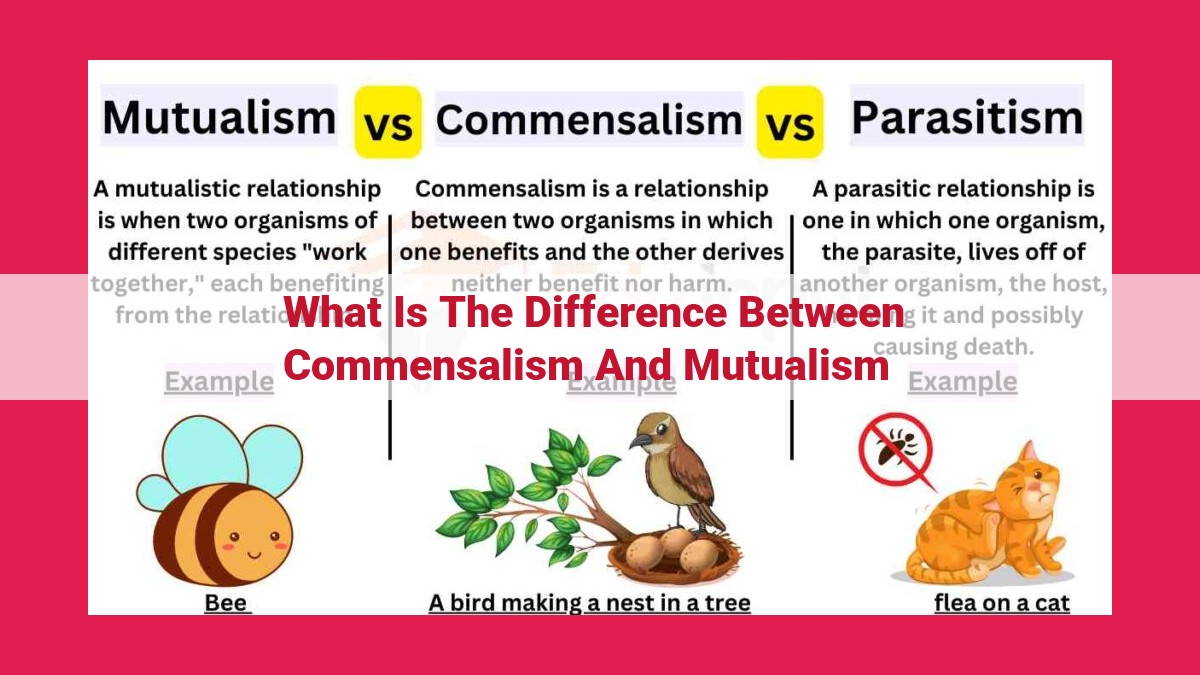Seo-Optimized Title: Exploring Commensalism: The Art Of Unilateral Symbiosis

Commensalism is a one-sided relationship where one species benefits (the commensal) while the other is unaffected (the host). In contrast, mutualism is a mutually beneficial relationship where both species gain advantages. Commensalism differs from parasitism, where the host is harmed, and amensalism, where one species is inhibited. Mutualism can involve direct resource exchange or indirect benefits like protection or enhanced nutrient availability. Understanding these interactions is crucial as they contribute to ecological stability and biological diversity.
Commensalism: The Hidden Helper in Nature’s Dance
Commensalism, a fascinating phenomenon in the world of ecology, paints a picture of a one-sided relationship where one organism benefits while the other remains unaffected. It’s like a dance where one partner leads while the other simply dances along.
Defining Commensalism
Commensalism, derived from the Latin words “cum” (with) and “mensa” (table), refers to a relationship where one organism (commensal) shares the same environment, food, or habitat with another organism (host) without causing any harm or benefit. The commensal gains access to resources while the host carries on as usual, unperturbed by their presence.
Distinguishing Commensalism from Parasitism and Amensalism
Commensalism differs from parasitism, where one organism (parasite) benefits at the expense of another (host), often causing harm. It also contrasts with amensalism, where one organism is inhibited or harmed by the presence of another, while the latter remains unaffected.
In commensalism, the host organism is neither harmed nor helped by the presence of the commensal. The commensal, on the other hand, may benefit by finding shelter, protection, or access to nutrients that would otherwise be unavailable.
Mutualism: Nature’s Harmonious Partnerships
Amidst the intricate tapestry of life on Earth, mutualism shines as a beacon of cooperation and interdependence. It’s a symbiotic relationship where both participants mutually benefit from their association.
Defining Mutualism
Mutualism is a reciprocal arrangement where two different species engage in an interaction that positively impacts both of them. This collaboration allows them to survive, thrive, and reproduce in an environment where they might otherwise struggle. Unlike commensalism, where one party benefits without affecting the other, mutualism is a true win-win scenario.
Mutualistic Bonds in Nature
Throughout the natural world, countless examples of mutualistic relationships abound. One iconic partnership is the symbiosis between ants and acacia trees. Ants fiercely defend acacia trees from herbivores, while the trees provide ants with sugary nectar from specialized glands and shelter within their hollow thorns.
Another remarkable example is the cooperation between pollinators and flowering plants. Bees, butterflies, and hummingbirds visit flowers to feed on their nectar. In the process, they unintentionally transfer pollen from one flower to another, aiding in the plant’s reproduction.
Characteristics of Mutualism
1. Obligate Mutualism: In some cases, mutualism is essential for the survival of both species. For example, coral relies on symbiotic algae for photosynthesis, while the algae receive protection and nutrients from the coral.
2. Facilitative Mutualism: In other instances, mutualism enhances the fitness of both participants but is not crucial for their survival. An example is the partnership between cleaner fish and reef fish. Cleaner fish remove parasites from reef fish, benefiting the latter by improving their health and reducing vulnerability to predators.
3. Trophic Mutualism: This type of mutualism involves a nutritional exchange. One species provides food or nutrients to the other, while the latter provides a vital service in return. One example is the relationship between sea anemones and clownfish. Sea anemones offer shelter and protection to clownfish, while clownfish attract prey to the anemone’s tentacles.
**Comparative Analysis of Commensalism and Mutualism**
Life on Earth is an intricate tapestry of interactions, where organisms intertwine in a multitude of ways. Commensalism and mutualism represent two distinct types of these relationships, each characterized by their unique dynamics and benefits.
Commensalism: A Unilateral Alliance
In commensalism, one species benefits from an association with another without harming or significantly affecting it. The beneficiary species, known as the commensal, gains advantages such as shelter, support, or access to nutrients. A classic example is the remora fish that attaches itself to sharks, feeding on scraps of food without impacting the shark.
Mutualism: A Synergistic Alliance
Mutualism, on the other hand, is a cooperative relationship where both participating species derive benefits. These benefits can be diverse, ranging from increased growth to enhanced survival. One iconic example is the symbiotic relationship between leguminous plants and nitrogen-fixing bacteria. The bacteria reside in nodules on the plant’s roots, converting atmospheric nitrogen into a usable form for the plant, while the plant provides shelter and nutrients to the bacteria.
Contrasting Key Features
The table below highlights the key distinctions between commensalism and mutualism:
| Feature | Commensalism | Mutualism |
|---|---|---|
| Benefit | One-sided | Mutual |
| Impact on other species | No harm | No harm |
| Dependence | Commensal not dependent | Both species dependent |
| Example | Remora and shark | Leguminous plant and nitrogen-fixing bacteria |
Types of Benefits and Interactions
In commensalism, the benefits are typically limited to the commensal species. The host species remains largely indifferent to the interaction. In mutualism, however, the benefits are shared. These benefits can be categorized into:
- Nutritional benefits: Access to nutrients or food resources
- Protection benefits: Defense against predators or environmental threats
- Reproductive benefits: Enhanced reproductive success or dispersal
- Habitat benefits: Provision of shelter or support
Commensalism and mutualism are fascinating examples of the diversity of biological interactions. Understanding these relationships is crucial for unraveling the complexity of ecosystems and appreciating the delicate balance of life on Earth. By studying these associations, we gain insights into the myriad ways that organisms have evolved to coexist and thrive in a dynamic and ever-changing environment.